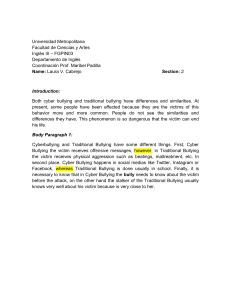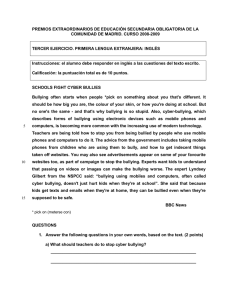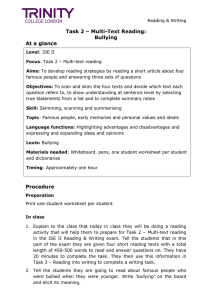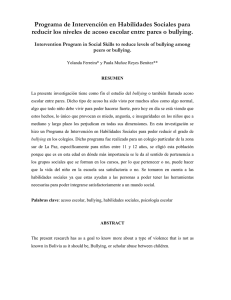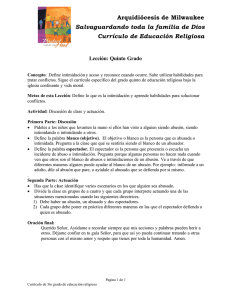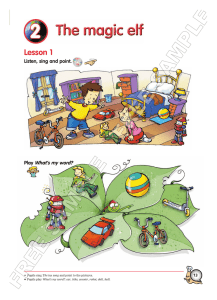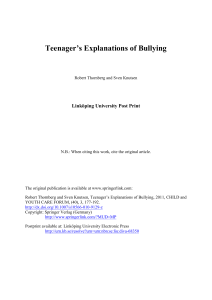Social status, gender, classroom climate and bullying among
Anuncio
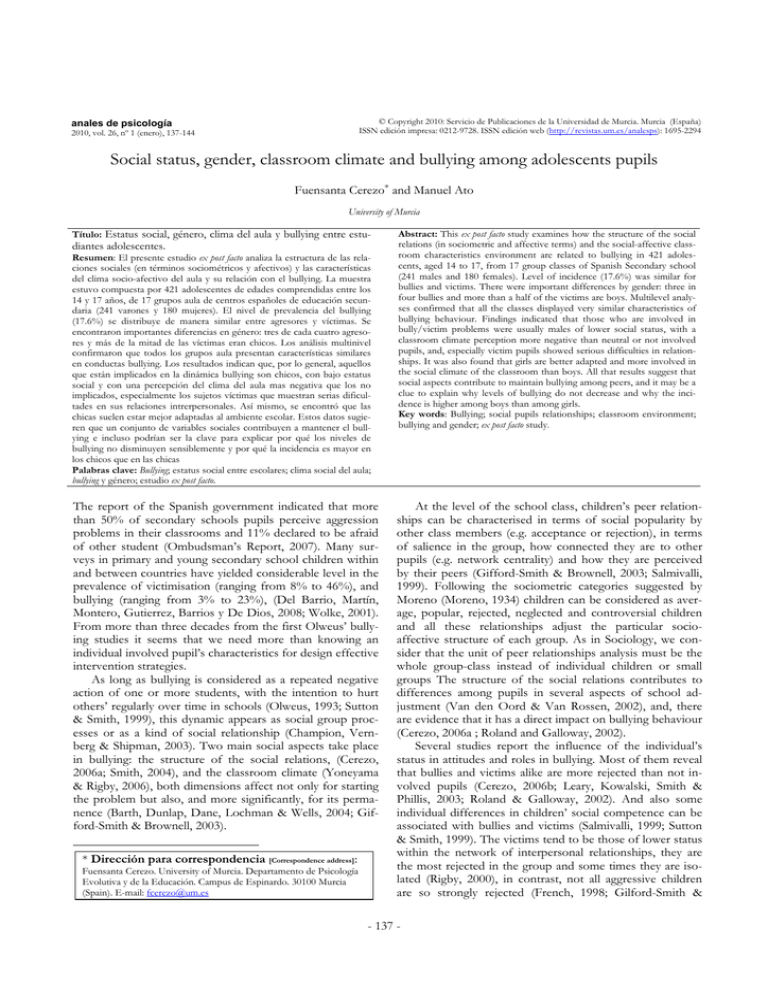
© Copyright 2010: Servicio de Publicaciones de la Universidad de Murcia. Murcia (España) ISSN edición impresa: 0212-9728. ISSN edición web (http://revistas.um.es/analesps): 1695-2294 anales de psicología 2010, vol. 26, nº 1 (enero), 137-144 Social status, gender, classroom climate and bullying among adolescents pupils Fuensanta Cerezo* and Manuel Ato University of Murcia Título: Estatus social, género, clima del aula y bullying entre estudiantes adolescentes. Resumen: El presente estudio ex post facto analiza la estructura de las relaciones sociales (en términos sociométricos y afectivos) y las características del clima socio-afectivo del aula y su relación con el bullying. La muestra estuvo compuesta por 421 adolescentes de edades comprendidas entre los 14 y 17 años, de 17 grupos aula de centros españoles de educación secundaria (241 varones y 180 mujeres). El nivel de prevalencia del bullying (17.6%) se distribuye de manera similar entre agresores y víctimas. Se encontraron importantes diferencias en género: tres de cada cuatro agresores y más de la mitad de las víctimas eran chicos. Los análisis multinivel confirmaron que todos los grupos aula presentan características similares en conductas bullying. Los resultados indican que, por lo general, aquellos que están implicados en la dinámica bullying son chicos, con bajo estatus social y con una percepción del clima del aula mas negativa que los no implicados, especialmente los sujetos víctimas que muestran serias dificultades en sus relaciones intrerpersonales. Así mismo, se encontró que las chicas suelen estar mejor adaptadas al ambiente escolar. Estos datos sugieren que un conjunto de variables sociales contribuyen a mantener el bullying e incluso podrían ser la clave para explicar por qué los niveles de bullying no disminuyen sensiblemente y por qué la incidencia es mayor en los chicos que en las chicas Palabras clave: Bullying; estatus social entre escolares; clima social del aula; bullying y género; estudio ex post facto. The report of the Spanish government indicated that more than 50% of secondary schools pupils perceive aggression problems in their classrooms and 11% declared to be afraid of other student (Ombudsman’s Report, 2007). Many surveys in primary and young secondary school children within and between countries have yielded considerable level in the prevalence of victimisation (ranging from 8% to 46%), and bullying (ranging from 3% to 23%), (Del Barrio, Martín, Montero, Gutierrez, Barrios y De Dios, 2008; Wolke, 2001). From more than three decades from the first Olweus’ bullying studies it seems that we need more than knowing an individual involved pupil’s characteristics for design effective intervention strategies. As long as bullying is considered as a repeated negative action of one or more students, with the intention to hurt others’ regularly over time in schools (Olweus, 1993; Sutton & Smith, 1999), this dynamic appears as social group processes or as a kind of social relationship (Champion, Vernberg & Shipman, 2003). Two main social aspects take place in bullying: the structure of the social relations, (Cerezo, 2006a; Smith, 2004), and the classroom climate (Yoneyama & Rigby, 2006), both dimensions affect not only for starting the problem but also, and more significantly, for its permanence (Barth, Dunlap, Dane, Lochman & Wells, 2004; Gifford-Smith & Brownell, 2003). * Dirección para correspondencia [Correspondence address]: Fuensanta Cerezo. University of Murcia. Departamento de Psicología Evolutiva y de la Educación. Campus de Espinardo. 30100 Murcia (Spain). E-mail: [email protected] Abstract: This ex post facto study examines how the structure of the social relations (in sociometric and affective terms) and the social-affective classroom characteristics environment are related to bullying in 421 adolescents, aged 14 to 17, from 17 group classes of Spanish Secondary school (241 males and 180 females). Level of incidence (17.6%) was similar for bullies and victims. There were important differences by gender: three in four bullies and more than a half of the victims are boys. Multilevel analyses confirmed that all the classes displayed very similar characteristics of bullying behaviour. Findings indicated that those who are involved in bully/victim problems were usually males of lower social status, with a classroom climate perception more negative than neutral or not involved pupils, and, especially victim pupils showed serious difficulties in relationships. It was also found that girls are better adapted and more involved in the social climate of the classroom than boys. All that results suggest that social aspects contribute to maintain bullying among peers, and it may be a clue to explain why levels of bullying do not decrease and why the incidence is higher among boys than among girls. Key words: Bullying; social pupils relationships; classroom environment; bullying and gender; ex post facto study. At the level of the school class, children’s peer relationships can be characterised in terms of social popularity by other class members (e.g. acceptance or rejection), in terms of salience in the group, how connected they are to other pupils (e.g. network centrality) and how they are perceived by their peers (Gifford-Smith & Brownell, 2003; Salmivalli, 1999). Following the sociometric categories suggested by Moreno (Moreno, 1934) children can be considered as average, popular, rejected, neglected and controversial children and all these relationships adjust the particular socioaffective structure of each group. As in Sociology, we consider that the unit of peer relationships analysis must be the whole group-class instead of individual children or small groups The structure of the social relations contributes to differences among pupils in several aspects of school adjustment (Van den Oord & Van Rossen, 2002), and, there are evidence that it has a direct impact on bullying behaviour (Cerezo, 2006a ; Roland and Galloway, 2002). Several studies report the influence of the individual’s status in attitudes and roles in bullying. Most of them reveal that bullies and victims alike are more rejected than not involved pupils (Cerezo, 2006b; Leary, Kowalski, Smith & Phillis, 2003; Roland & Galloway, 2002). And also some individual differences in children’ social competence can be associated with bullies and victims (Salmivalli, 1999; Sutton & Smith, 1999). The victims tend to be those of lower status within the network of interpersonal relationships, they are the most rejected in the group and some times they are isolated (Rigby, 2000), in contrast, not all aggressive children are so strongly rejected (French, 1998; Gilford-Smith & - 137 - 138 Fuensanta Cerezo and Manuel Ato Brownell, 2003), even some aggressive pupils can get support from some peers, and they enjoy positions of social power and influence in the group (Buelga, Musitu y Murgui, 2009; Cerezo, 2008). Classroom climate (Moos, 1979) is a term that sums up the main features of the class environment that coexist with all the learning processes, and have to do with the way subjects interact and with the attitude they do their tasks. Previous research in this vein primarily focused on the relationship between social climate in the classrooms and bullying from an overall perspective, which appraises the relationships between members of the educational community and the feeling of security within the schools (Clémence, 2001; Hayden & Blaya, 2001). Barth et al. (2004) analysing the teachers’ perceptions, found that poorer classrooms environment were associated with higher levels of student aggression, poor peer relations and poor academic focus, but the pupils’ perspective is ignored. Recent studies of school climate and the relationship between the individual perceptions of the classroom climate perception and their bully/victim status suggest that adolescent students who are involved in bully/victim problems are less positive in their appraisals of school/classroom climate than other students (Díaz-Aguado, 2005; Yoneyama & Rigby, 2006), and take to the fore that it is necessary to examine a wider range of classroom characteristics such as good integration and realisation of classroom tasks; encouragement of mutual support, the appreciation of the effort made, organisation and respect for the established norms and the fostering of participation and creativity. Objectives From the studies cited above, arise the need to know how social relationships and what environmental elements of the classroom climate are connected to those pupils involved in bullying. In the present study ex post facto, we make point in how gender, social status and pupils’ perception of the school climate (in terms of relationships, self-realization, stability and change) are associated to bullying behaviours and what social and affective characteristics are implicated. Firstly, considering each group-class as a unit of analysis and, secondly, taking into account the entire sample as a whole. Three main issues underpin this objective: (a) The detection of situations of peer abuse in school groups contexts and the evaluation of how gender and social-affective structure is connected to such a dynamics, (b) What specific social and sex characteristics can be associated to bullies, to victims and to neutral pupils and which of them are relevant to maintaining bullying, and (c) What aspects of the school social climate favours bullying. Summing up, the research tries to deepen the knowledge of the relation between the social and affective characteristics in the class group and bullying, and which of them can be associated to bullies and victims and what is the role of gender in those situations. anales de psicología, 2010, vol. 26, nº 1 (enero) Method Participants 17 group classes of Spanish State Secondary Schools participated in this study. The sample comprised 421 pupils, aged between 14 and 17 years old, 241 boys and 180 girls. Instruments To address the objectives of the study pupils completed two questionnaires: Bull-S questionnaire (Cerezo, 2000/ 2002) for measuring the social-affective structure and peer relationships and bullying, and the Moos School Social Climate Scales CES (Moos, Moos & Trickett, 1984, Spanish version, 1989) for knowing the perception of school climate. The Bull-S test (Cerezo, 2000/ revised in 2002) was designed to measure three general aspects of bullying: (1) Sociometric position; (2) Bullying characteristics; and (3) Situational properties. Students’ form (form A) it is based on peer nominations and in self evaluation. Consists of 15 items grouped around three topics: Sociometric position: (4 items). By peer nominations, with no more than three. Evaluates the real and expected sociometric characteristics of each of the pupils, and of the class as a whole, by the analysis of acceptance and rejection indices. Aggression-Victimisation: (5 items). Enable the detection of bullying dynamics and assess some physical and personal aspects of bullies or to victims. The scores were coded using percentage nomination. It was assumed that a pupil is classified as a Bully or aggressor if he or she is perceived by at least 25% of peers as one who maltreats others. Victim when he or she is perceived by at least 25% of the class group as one who usually is bullied by other/s. ProvocativeVictim is defined as a case what appears in both categories: bully and victim, at least 25% of the class group. All the rest are considered uninvolved or Neutral pupils. Situational properties: Included 5 items that take peer report procedure by a Licker scale, to estimate type, place, and frequency of aggressions, as well as how dangerous or serious bullying is perceived by pupils, and how safe they feel at school. The Bull-S Spanish version showed satisfactory levels of reliability (Cronbach’s alpha = .73) and the factorial validity explains 75.6% of total variance (see Cerezo & Ato, 2005; Cerezo, 2006b). The Moos School Social Climate Scales CES (Moos, Moos & Trickett, 1984, Spanish version, 1989). The CES scales assess what pupils appreciate about their class environment especially focused on the pupil-teacher and pupilpupil relationships and the class organisation structure. It consists on 90 true/false items that defines four dimensions: Relationships, made up of three subscales. This evaluates the 139 Social status, gender, classroom climate and bullying among adolescents pupils degree of communication and free expression of the group in the classroom, the level of cohesion and the degree of conflictive interaction; Self-realization, made up of two subscales. This evaluates the importance of certain academic processes development within the group: tasks realizations and competitively; Stability, made up of three subscales. This evaluates the structure, organisation of the class and the importance given to norms and the degree of control that teachers have in class; and finally, Change, with one only subscale. This evaluates the importance given to innovation and to changes in the teaching-learning models. Alpha average coefficient for the Spanish version was 43.2. Procedure The study received the ethical permission from the University of Murcia. Head teachers and involved class teachers consented to participate in the study. Parents were informed in a special meeting and consent forms were given or posted, asking them to sign if they wanted their child not to take part. Schools were placed to hold parents meeting to inform global results. All students selected participated in the study. Data were collected at school classes in a two hour session. Specially trained research assistants administrated the questionnaires in each group. Teachers were absent during this time. Detailed instructions on how to respond to questionnaire and explanations of what is meant by bullying were given before students filled out them. The students were strongly encouraged to give sincere answers and they informed that they were absolutely confidential ones. For comparison studies, the entire sample was divided into four subgroups named: Neutral (for non involved pupils), Bully, Victim and Provocative-Victim, according to the Bull-S questionnaire (as explained above). Due to the re- duced number of subjects in the Provocative-Victim subgroup (n=3), it was eliminated for inference purposes. Results Data were analysed through several statistical tests. Frequencies for descriptive analysis were carried out with Chi-square test for confirming differences in the distribution of general data, then, to obtain a general impression of the factors that affect school adjustment, variation in adjustment scores were partitioned into child, classroom and other residual contributions by using a Multilevel analysis (Goldstein, 1995). These contributions were estimated on basis of the observed differences in adjustment scores among classes within school, and among children within classes. When specific variables are studied, estimates of variance components may give an idea about the effect sizes of the variables and may provide information about the relative importance of the different components (Van den Oord &Van Rossem, 2002). The analysis of the differences between Neutral, Bully, Victim subgroup were carried out by one factor ANOVAS with Bonferroni post-hoc test. Correlation analyses were used for knowing how the variables were grouped for each involved subgroup, but due to the reduced sample, those results must be taken as a prospective for future studies. All statistical analyses were carried out by using SPSS system (version 15.0). Descriptive analysis for roles associated to bullying Descriptive analysis for roles in school bullying, by gender and age, are summarised in Table 1. Table 1: Total frequencies by age and sex. NEUTRAL BULLY VICTIM PROV-VICTIM Total Bullying (% Total) 14 (169) 136 (80.5%) 14 (8.3%) 17 (10.1%) 2 (1.2%) 33 (19.5%) 15 (157) 132 (81.4%) 11 (7.0%) 13 (8.3%) 1 (.6%) 25 (15.9%) AGE 16 + (95) 79 (83.16%) 11 (11.58%) 5 (5.26%) 0 16 (20.3%) Results indicated that bullying dynamic was found in all classroom groups. Although majority of students (82.4%) are not involved or neutral, 17.6% are involved in bullying as bully and/or victim: 8.6% (36) bully, 8.3% (35) victim and 0.7% (3) as provocative-victim. These figures are in line with TOTAL (421) 347 (82.4%) 36 (8.6%) 35 (8.3%) 3 (.7%) 73 (17.34%) M (241) 189 (78.4%) 28 (11.6%) 23 (9.5%) 1 (.4%) 52 (21.57%) SEX F (180) 158 (87.8%) 8 (4.4%) 12 (6.7%) 2 (1.1%) 22 (12.22%) previous studies that rated the incidence of bullying between 16.7% and 17.4% (Cerezo, 2009; Cerezo & Ato, 2005). No significant statistical differences were detected by age between the three main subgroups (Pearson χ2 (12) = 8.032; p>.05). In terms of absolute frequencies, 14 year old pupils are the most involved, but among the older pupils the inci- anales de psicología, 2010, vol. 26, nº 1 (enero) 140 Fuensanta Cerezo and Manuel Ato dence increases, which suggests that those who exceed the average age of the group class are at risk of participating in bullying. There were statistical differences in gender for roles in school bullying (Pearson χ2 (3) = 9.022; p=.029). The levels of incidence were: 21.6% (boys) and 12.2%, and in relative terms, the distribution of bullies and victims pupils between boys and girls is much greater for boys in both roles. Incidence of the socio-affective structure, by groups, in bullying In order to test the presence of heterogeneous variance among classes, with each variable of the Bull-S test a random intercept model (Snijders & Boskers, 1999) was performed with each variable of the Bull-S test. We used class with 16 groups as level 2 and pupils as level 1. In spite of the reduced sample size, the results of this analysis indicate that, with the exception of Aggressive variable, covariance parameters for class level were irrelevant and did not reached significance in any case, so all groups can be considered as one homogeneous group. The cohesion indices (density indices) are also quite similar in all groups showing medium level scores (51.0 – 57.6). Table 2: Random effects. Multilevel Analysis. Covariance estimates. Variables Variance (classes) Accepted 0.12 Accepted Expectation 0.21 Rejection 0 Rejection Expectation 0.2079 Physical strength 0.000 Cowardice 9.66 Aggressive 24.10 Victim 4.11 Provoking 12.00 Leave-out 2.13 Variance (subjects) 13.94 9.04 22.79 16.80 307.40 144.58 165.10 177.07 186.57 170.95 Socio-affective structure and bullying in the entire sample We used different one-way ANOVA and Multiple Comparisons with each variable of the Bull-S test. And post hoc Bonferroni alpha was applied on pairwise subgroups. Table 3 summarises the results. Table 3: ANOVAs and multiple comparisons. Variables F-tests Rejection F(2; 418)=37.06 P=.000 F(2; 418) = 23.10 P= .000 Rejection Expectation Physical strength F(2; 418)=34.731 P=.000 Cowardice Provoking F(2; 418)=57.576 P=.000 F(2; 418)=385.465 P=.000 Leave-out F(2; 418)=108.9 P=.000 Frequency of aggressions F(2; 398)= 14.171 P=.000 Importance given to bullying Brown-Forsythe F(2; 398)= 2.779 P=.063 Relationships F(2; 350)= 5.119 P=.006 Affiliation F(2; 350)= 11.974 P= .000 anales de psicología, 2010, vol. 26, nº 1 (enero) Intraclass correlation .01 .02 0 .01 0 .06 .13 .02 .06 .01 Mean subgroups differences Neutral-Bully = 3.767 Neutral-Victim= -6.280 Bully-Victim=-2.513 Neutral-Bully = -3.229 Neutral-Victim= -3.909 Bully-Victim=-6.679 Neutral-Bully = -23.107 Neutral-Victim= 3.04 Bully-Victim=26.147 Neutral-Bully = -5.753 Neutral-Victim= -21.07 Bully-Victim=-15.316 Neutral-Bully = -38.41 Neutral-Victim= -1.974 Bully-Victim=36.433 Neutral-Bully = -2.07 Neutral-Victim= -29.191 Bully-Victim=-27.123 Neutral-Bully = -.818 Neutral-Victim= -.845 Bully-Victim=-.027 Neutral-Bully = .084 Neutral-Victim= -.447 Bully-Victim=-.531 Neutral-Bully = -2.498 Neutral-Victim= 3.451 Bully-Victim=5.950 Neutral-Bully = -1.658 Neutral-Victim= 8.684 Bully-Victim=10.342 P .000 .000 NS .000 .000 NS .000 NS .000 .001 .000 .000 .000 NS .000 NS .000 .000 .001 .000 NS NS .070 NS NS .037 .005 NS .000 .000 141 Social status, gender, classroom climate and bullying among adolescents pupils From the analysis of the differences on Bull-S test variables, we found something relevant: the variable Acceptance (being chosen) showed no significant differences in multiple pairwise comparisons among the three main subgroups. This suggests that there were isolated pupils not only among bullies or victims. The variable Rejection showed significant differences between bullies and neutral (p=.000), and also between neutral and victim pupils (p=.000), but no significant differences were found between bully and victim pupils (p= .069), which is in line with other studies (Gifford-Smith & Brownell, 2003; Olweus, 1993), although the slight difference appreciated between them suggests a trend against Victims as more rejected than Bullies (mean differences = 2,531). We also found differences in Rejected Expectation (expectative of been rejected) between neutral and bully (p=.000), and between neutral and victim (p= .000) but no between bully and victim pupils. These results indicate that in the social class network, those pupils that are involved in bullying are more rejected than others and they are aware of this situation. Other Bull-S variables associated with the profiles of bully and victim roles Comparisons between subgroups shown other variables associated to bullying roles (see Table 3). These variables are Physical Strength, where neutral and bully showed differences in favour of bully subgroup (p=.000), and also between bully and victim (p=.000); Provoking, comparing neutral and bully showed differences in favour of bully in (p=.000), also between bully and victim (p= .000). Cowardice, comparing neutral and bully showed differences in favour of bully in (p=.011), between neutral and victim (p=.000) in favour of victim; and between bully and victim (p= .000) in favour of victim. Leave out of activities also showed significant differences (p=.000) in favour of victims in all cases. These results indicate that bully is perceived as the strongest and the most provocative pupil in the class, and more coward than neutral pupil; meanwhile victim is perceived as the most coward of the class group and he or she is usually left out of activities. Summing up, analyses of the variables associated to bullying showed that, most of pupils involved in bullying are males, that are more rejected than neutral or uninvolved pupils, and they have more expectations of being rejected. By subgroups, bullies showed some values which reveal that they are somehow admired, such as being the strongest of the group, as well as being those who start fights and the ones who usually bully others. In contrast, social and personal aspects in victims, to some extent, favour their being placed in defenceless situations, because they are the most rejected of the group, and they are also seen as coward pupils and they are usually excluded by others from games and activities. Situational Bull-S variables Pearson χ2 test for frequencies by subgroups shows that, among the Way of aggression, insults and threats are the most usual way (41.5%) for all of the sample, and the first Place where aggressions usually occur is in their own classroom (57%), but pupils differ in the Frequency they take place. So more neutral say: “Once or twice a week”, whereas bully and victim say: “Almost every day” (p=.000). Also in Importance given to bullying, there are differences (p=.039): most neutral and bully pupils say that those situations are not important (65.1%; 80.6%), meanwhile 41% of the victim say that those situations are very serious. Similarly, about Feeling secure in school, 19.8% of pupils say they feel secure or very secure in school. By subgroups, we found relevant differences (p=.000): most neutral feel very secure (72%), also most bully pupils (74.2%), but only 44.2% of victim pupils. Among victim pupils, 55.8% admit to feeling not secure or even very insecure in school. ANOVA and Multiple Comparisons with post hoc Bonferroni alpha test was applied on pairwise subgroups, and also Brown-Forsythe test was also applied in one variable (Importance given to bullying) where homogeneity of variance was violated (Brown & Forsythe, 1974). Results showed that Frequency of bullying is the only dimension that point significant differences: between bully and neutral (p=.001) and between victim and neutral (p=.000), but there were no differences between bully and victim, which suggest that those who are involved in bullying appreciate aggressive situations more frequently than those who are not involved. We also found a slight but no significant difference in the variable Importance given to bullying, between neutral and victim (p=.063). Comparisons between boys and girls in bullying attitude showed differences in Way of aggressions (F= 6.695; p=.010): girls report Rejection more often than boys and also girls indicate more Frequency of aggressions (F=4.071; p=.044) than boys. Differences in the appreciation of the social and affective climate of the classroom ANOVA and Multiple Comparisons with post hoc Bonferroni alpha and Brown-Forsythe test (with heterogeneity variance) was applied on pairwise subgroups to the dimensions of CES test. Table 3 summarises the results. The results indicate that of the three subgroups, most CES dimensions showed no significant differences, and the means of the variables reached medium or low levels. That is to say that, on average, pupils perceive social climate in the classroom in a very similar way. Only the Relationships dimension appears as a differentiating element. Here, victims are the ones who scored the lowest, compared with neutral (p=.037) and with bully (p=.005). The analysis with the subscales of this dimension, shows Affiliation as the clue for these differences (p=.000). Those findings indicate that, anales de psicología, 2010, vol. 26, nº 1 (enero) 142 Fuensanta Cerezo and Manuel Ato neutral and bullies alike perceive the classroom atmosphere in terms of possible affinity, friendship and even interest, while victims perceive it in an opposite way, and they also perceive the social climate in the classroom with a certain amount of hostility and isolation. Comparisons between boys and girls in the appreciation of social climate in the classroom, showed differences in Change (F= 6.674; p=.010), in Implication (F=8.656; p=.003) and in Help (F=4.095; p=.44), which reveals that girls appreciate that their relationships with their classmates and teachers are more confident and friendly and also that they think that teachers help and care about their pupils more than do boys. Profiles associated to bully and victim pupils In order to confirm which specific characteristics are associated to each of the subjects involved, we performed correlation analyses. Tables 4 and 5 provide a summary of the basic variables associated to Bully and Victim subgroups with Bull-S variables and with CES variables. Those results must be taken as a prospective study due to the reduced number of subjects, but they can give us an approximate estimation. Correlation analyses between Gender and Bull-S variables for bullies and for victims reveal some differences (see table 4). Summing up these differences we can point out the following: For bullies Gender goes with Rejection Expectative and Provoke; for victims Gender only goes with Provoke. Bullies associate Acceptance with Strength and Rejection with Rejection Expectative and Leave out, and with Frequency in negative way; meanwhile victims associate –Acceptance Expectation and Place -in positive way, and -Rejection, Rejection Expectative, Coward and Leave out -in negative way. For victims, Rejection goes with Rejection Expectative, Leave out and Coward in positive way and with Acceptance Expectative and Place in negative way. Victims also associate Frequency, Security and Seriousness. Table 4: Correlations for Bullies and for Victims with Gender and BULL-S variables. Variables 1 2 3 4 5 6 7 B V B V B V B V B V B V B V 1 1 1. Sex 1 1 2. Accept -.52** 1 1 3. Reject. .66** .59** -.36* 1 1 4. A-Exp. .37* -.38* .70** .82** 1 1 5. R-Exp. .36* 1 1 6. Streng. -.46 ** .68** .32* .57** 1 1 7. Cowa. .32* .14* .37* .36* 8. Provo. -.53 ** .68** .84** .33* .73** .09* .62** 9. Leave-.32* -.38* 10. Ways .37* 11. Place 12. Freq. 13. Serio. 14. Secu. *p<.05; **p<.01 -.50 ** -.34** 8 B V 9 V B 1 1 -.06* 1 .30* B 10 V 1 1 B 13 B V 1 -.54** -.40* .60** -.33* .49* 1 1 .42** .34* -.27* -.35* From this analysis, we can assume that these two subgroups are perceived in two different ways: bully pupils are more accepted than victims because they are considered strong boys meanwhile victims are more rejected because they are considered cowards and they are usually left out of activities. Gender, for both subgroups, correlates with Pro- 12 V 1 1 -.62** .19* voke, so boys who are involved in bullying are those who start fights and provoke others. Correlation analyses with CES variables indicate that Relations is the significant scale for bullies and victims alike (See table 5), and Change scale is significant only for bullies. Table 5: Correlations for Bullies and for Victims with Gender and CES variables. Variables 1. Sex 2. Relation 3. Implication 4. Affiliation 5. Help 6. Self-Real 7. Stability 8. Change B 1 1 V 1 (.54) 2 B V B 1 .65** .48** .78** .48** 1 .75** .58** .54** .37* 1 .38* - *p<.05; **p<.01 anales de psicología, 2010, vol. 26, nº 1 (enero) 3 V B 4 V 1 - 1 - 1 - 5 B V B 1 .49** 1 .42* 1 - 6 V B 7 V B 8 V 1 - 1 - 1 1 1 Social status, gender, classroom climate and bullying among adolescents pupils Three subscales compose Relations: Implication, Affiliation and Help, all of which are related to bullies and victims. Discussion and Conclusions Our results, like in previous studies carried out with different samples (Cerezo, 2006a), confirm the existence of peer violence in all school groups, and mark stable rates in Spanish schools (Cerezo, 2009), but show a higher incidence in Spain than in other European schools (Solberg & Olweus, 2003). This point only suggests a trend which is worth investigating further. The study indicates that the incidence of bullying by gender is unbalanced: more boys than girls are involved both in bully and victim roles (Cerezo, 2009), which is in line with other international results (Olweus, 1993; Salmivalli, 1999) The group-classes analysis by the Bull-S questionnaire showed that all the variables considered are stable and independent of the class used. That is to say, peers link specific and different characteristics to bully or to victim pupils, and they do so in a similar way whatever the group-class chosen. Regarding bullying, our results reveal that, within the dynamics of the affective relationships of the group, both bullies and victims are considered equally rejected as compared to neutrals, and they expect to be considered so. Personal characteristics associated to a bully are: physical strength and provocation, while characteristics associated to victim are: cowardice and left out of activities. This indicated that victims are worse placed than bullies in the network of interpersonal relationships, because they are rejected and are also considered cowards, while bullies are considered as strong. Of all Situational Conditions, frequency of aggressions makes the difference: for involved pupils aggressions happens almost everyday versus the once or twice a week reported by the rest of the class, and only victims give importance to the situation. Victims also feel less secure in school. This point reveals that victims are alone and nobody cares about them because the rest are not concerned about the seriousness of the situation, and it could support the persistence of bullying. To some extent, gender acts as distinguishing factor in how pupils perceive the situation, for instance, in the type of aggressions, most of the boys indicate insults and threats, but girls add rejection. There are also differences in the frequency of aggressions depending on the gender, for boys it occurs more frequently than for girls. 143 As regards the social climate, the Social Relationships dimension is the main differentiating element between Neutral, Bullies and Victims pupils, in its three aspects: Affiliation, Implication and Help which are the clue to that difference, victims are the worst placed in the network of the classroom because they are isolated and probably they find very few occasions for communication with their peers. They do not get on well with the rest and they do not feel themselves integrated within the class-group. These results also indicate that girls appreciate that their relationships with their classmates and teachers are more confident and friendly than boys do, and that teachers help and care about their pupils more than boys appreciate, a characteristic which can be connected to the low level of incidence of bullying among girls. Additional results, from correlation analyses, suggest the existence of certain differentiating trends among bullies as a group and also among victims. It seems that the two subgroups involved represent different categories (Coie, Dodge, Terry & Wright, 1991; Olweus, 1993). Bullies can be those boys with proactive aggressiveness, who associate acceptance with being considered physically strong. There are boys with reactive aggressiveness, who group aspects like high rejection, being left out of activities and being considered a coward. Victims appear as a very compacted group, which can be considered as passive victimisation- which gathers together being considered a coward, being left out of games and activities and being rejected. A low level of interpersonal relationships is another dimension associated to victims. Although further studies are required, these results constitute a crucial aspect for the understanding of the bullying phenomenon: the perspective of the heterogeneity in the group of bullies and the passive attitude among the group of victims Bullying is now seen as a widespread school problem and many methods have been adopted for coping with it, but after more than 30 years of research the strategies have had little success. Current study suggests the need to include a work focus on relationships in school, rather than specifically on pupils involved in bullying (Roland & Galloway, 2002). This study takes to the fore that there is a general lack of consideration towards other among pupils in schools (especially among boys). It is necessary to change the target for satisfactory interventions because it is not enough to attend to pupils at risk. Rather, it is essential to improve the social climate and thus foster greater awareness of the problems of others in schools. References Barth, J. M., Dunlap, S. T., Dane, H., Lochman, J. E. & Wells, K. C. (2004). Classroom environment influences on aggression, peer relations, and academic focus. Journal of School Psychology, 42, 115-133. Buelga, S., Musitu, G., de Olavide, P. y Murgui, S. (2009). Relaciones entre la reputación social y la agresión relacional en la adolescencia. International Journal of Clinical and Health Psychology, 9 (1), 127-141 Cerezo, F. (2000/ Revised 2002). Bull-S. Test de evaluación de la agresividad entre escolares. (Bull-S. A questionnaire for measuring bullying among school children). Madrid: Albor-Cohs. Cerezo, F. (2001). Personality variables associated to bullying (aggressors versus victims) in 10 to 15 years old pupils. Anales de Psicología, 17 (1), 37-44. anales de psicología, 2010, vol. 26, nº 1 (enero) 144 Fuensanta Cerezo and Manuel Ato Cerezo, F. (2006a). Análisis comparativo de variables socio-afectivas diferenciales entre los implicados en bullying. Estudio de un caso de víctima-provocador. Anuario de Psicología Clínica y de la Salud, 2, 27-34. Cerezo, F. (2006b) Violencia y victimización entre escolares. El bullying; estrategias de identificación y elementos para la intervención a través del Test Bull-S. Revista de Investigación Psiucoeducativa, 4 (2) 106-114. Cerezo, F. (2008). Acoso escolar. Efectos del Bullying. Boletín de Pediatría, 48, 353-358.. Cerezo, F. (2009). Bullying. Análisis de la situación en las aulas españolas. International Journal of Psychology and Psychological Therapy, 9(3), 383-394. Cerezo, F. & Ato, M. (2005). Bullying among Peers in Spanish and English pupils. A Sociometric Perspective using the BULL-S Questionnaire. Educational Psychology, 25 (4), 353-367. Champion, K., Vernberg, E., & Shipman, K. (2003). Nonbullying victims of bullies: Aggression, social skills and friendship characteristics. Applied Developmental Psychology, 24, 535-551. Clémence, A. (2001). Violence and security at school: The situation in Switzerland. In E. Debarbieux & C. Blaya (Dir.): Violence in schools. Ten approaches in Europe. Issy-les-Moulineaux., FR.: ESF Editeur. Coie, J., Dodge, K., Terry, R. & Wright, V. (1991). The role of aggression in peer relations: Analyses of aggression episodes in boys’ play groups. Child Development, 59, 815-829. Del Barrio, C., Martín, E., Montero, I., Gutiérrez, H., Barrios, A. y de Dios, M..J. (2008). Bullying and social exclusion in Spanish secondary schools: National trends from 1999 to 2006. International Journal of Clinical and Health Psychology 8 (3), 657-677. Díaz-Aguado, M. J. (2005). La violencia entre iguales en la adolescencia y su prevención desde la escuela. Psicothema, 17 (4), 549-558. French, D. (1998). Heterogeneity of peer rejected boys: Aggressive and nonaggressive subtypes. Child Development, 59, 976-985. Gifford-Smith, M.E. & Brownell, C.A. (2003). Childhood peer relationships: social acceptance, friendships, and peer networks. Journal of School Psychology, 41, 235-284. Goldstein, H. (1995). Multilevel statistical models. London, UK.: Arnold. Hayden, E. & Blaya, C. (2001). Violent and aggressive behaviour in English schools. In E. Debarbieux y C. Blaya (Dir.): Violence in schools. Ten approaches in Europe. Issy-les-Moulineaux. FR.: ESF Editeur. Leary, M. R., Kowalski, R. M., Smith, L. & Phillis, S. (2003). Teasing, rejection and violence: Case studies of school shootings. Aggressive Behavior, 29 (3), 202-214. Montero, I. y León, O. G. (2007). Guía para nombrar los estudios de investigación en Psicología. International Journal of Clinical and Health Psychology 7 (3), 847-862. Moos, R.H. (1979). Improving social settings by climate measurement and feedback. In R. Munoz, L. Snowden & J. Kelly (Eds.), Social and psychosocial research in community settings. (145-171). San Francisco: Jossey-Bass. Moos, R.H., Moos, B.S. & Trickett, E.J. (1984). The Social Climate Scales. Classroom environment scales. (CES). Madrid.: TEA Moreno, J. L. (1934). A new approach to the problem of human interrelations. Washington, DC.: Nervous and Mental Disease Publishing. Olweus, D. (1993). Bullying at school. What we know and what we can do. Oxford, UK.: Blackwell. Ombudsman’s Report. (2007). Informe sobre la violencia escolar: El maltrato entre iguales en la educación secundaria obligatoria. (Bullying report in Secondary Spanish Schools) Madrid. Oficina del Defensor del Pueblo. Rigby, K. (2000). Effects of peer victimisation in schools and perceived social support on adolescent well-being. Journal of Adolescence, 23 (1), 5768. Roland, E. & Galloway, D. (2002). Classroom influences on bullying. Educational Research, 44(3), 299-312. Salmivalli, C. (1999). Participant role approach to school bullying: implications for intervention. Journal of Adolescence, 22, 453-549. Smith, P.K. (2004). Bullying: recent developments. Child and Adolescent Mental Health, 9 (3), 98-103. Snijders, T. & Bosker, R. (1999). Multilevel analysis: an introduction to basic and advanced multilevel modelling. Thousand Oaks, CA.: Sage Publications. Solberg, M. E. & Olweus, D. (2003). Prevalence estimation of school bullying with the Olweus Bully/Victim questionnaire. Aggressive Behavior, 29,239-268. SPSS, Inc (2006). SPSS for Windows, version 15. Chicago, Il: SPSS, Inc. Sutton, J.& Smith, P.K. (1999). Bullying as a group process: An adaptation of the participant role approach. Aggressive Behavior, 25, 97-111. Van den Oord, E. J. C. G. & Van Rossen, R. (2002). Differences in first graders’ school adjustment: the role of classroom characteristics and social structure of the group. Journal of School Psychology, 40 (5), 371-394. Wolke, D. (2001). Bullying and victimization of primary school children in England and Germany: Prevalence and school factors. British Journal of Psychology, 92, 673-696. Yoneyama, S. & Rigby, K. (2006). Bully/victim student & classroom climate. Youth Studies Australia, 25 (3), 34-41. (Artículo recibido: 23-1-2009; revisado: 7-2-09; aceptado: 26-2-2009) anales de psicología, 2010, vol. 26, nº 1 (enero)
